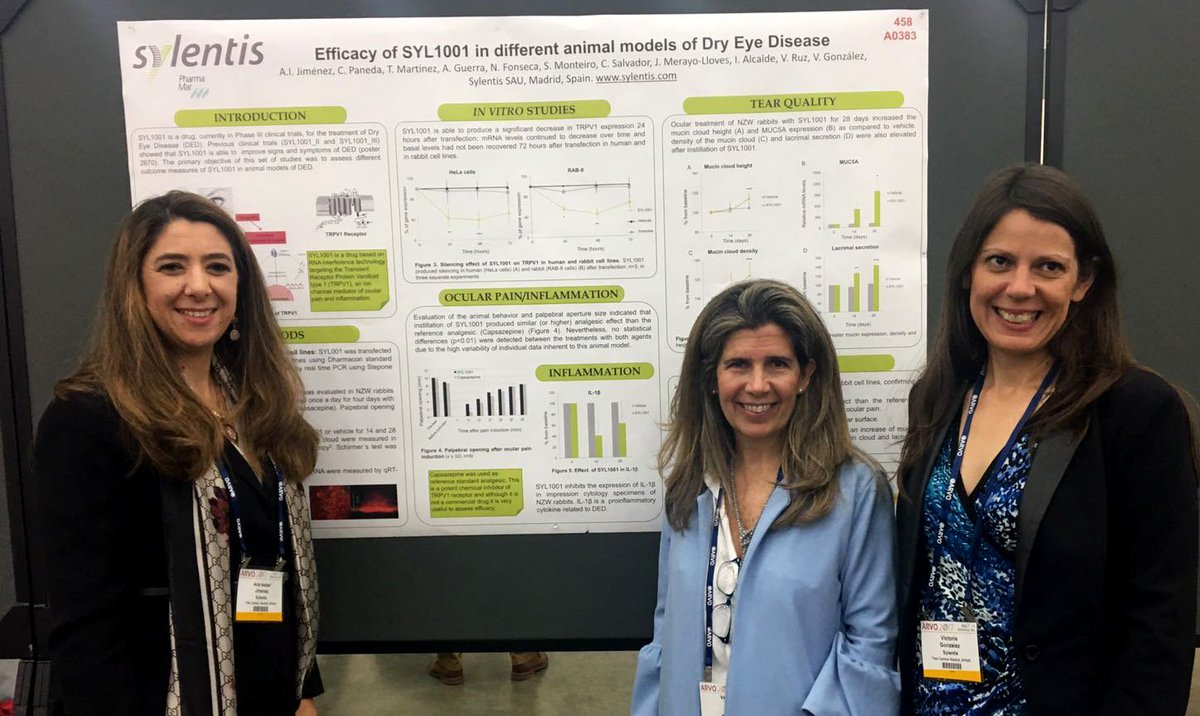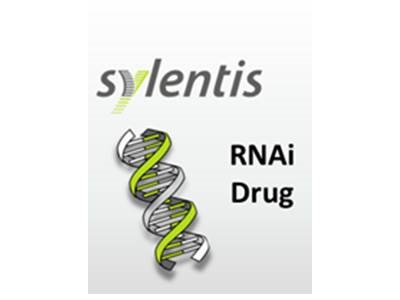29 Abril 2018 :
 Tivanisiran ( SYL1001 ) , a new treatment for Dry Eye Disease, that improved signs and symptoms in clinical trials .
Tivanisiran ( SYL1001 ) , a new treatment for Dry Eye Disease, that improved signs and symptoms in clinical trials .AuthorBlock: Ana Isabel Jimenez , Veronica Ruz , Victoria Gonzalez , Covadonga Paneda, Tamara Martinez, Beatriz Vargas, Anne Marie Bleau .
...
**************************************
1 Mayo 2018 :
 Sylentis ( PharmaMar Group ) ha desarrollado un compuesto ( SYL136001v10 ) para tratar enfermedades de la retina, como la degeneración macular asociada a la edad y la retinopatía diabética, que se administrará mediante gotas oftálmicas en lugar de inyecciones intraoculares.“Su eficacia ha sido probada en modelos animales y los ensayos con humanos se iniciarán a finales de 2018" según Covadonga Pañeda, gerente de I+D de Sylentis. La firma tiene previsto encargarse de los primeros estudios clínicos de eficacia. Una vez demostrada la prueba de concepto en humanos, tratará de licenciar el fármaco a una multinacional.
Sylentis ( PharmaMar Group ) ha desarrollado un compuesto ( SYL136001v10 ) para tratar enfermedades de la retina, como la degeneración macular asociada a la edad y la retinopatía diabética, que se administrará mediante gotas oftálmicas en lugar de inyecciones intraoculares.“Su eficacia ha sido probada en modelos animales y los ensayos con humanos se iniciarán a finales de 2018" según Covadonga Pañeda, gerente de I+D de Sylentis. La firma tiene previsto encargarse de los primeros estudios clínicos de eficacia. Una vez demostrada la prueba de concepto en humanos, tratará de licenciar el fármaco a una multinacional.Presentacion del SYL136001v10 con fecha 1 de Mayo 2018 :
Topical administration of siRNA targeting NRARP as a new treatment for choroidal neovascularization .
8:15am - 10:00am
Tue, May 01 By Veronica Ruz // Sylentis .
Abstract Author Block: *Veronica Ruz, Covadonga Paneda, Tamara Martinez, Susana Monteiro, Amor Guerra, Victoria Gonzalez, Ana Isabel Jimenez
Results :
SYL136001v10 was selected as the most potent of the sequences studied, causing a maximal reduction of NRARP mRNA levels of 80% in human cells and 70% in rat cells. This effect was observed without reduction of cell viability. SYL136001v10 was administered as a single dose in eye drops to rabbits and analysis of the tissues collected showed that the intact compound was present in retina. Repeated administrations of the compound to rats with laser induced CNV-lesions showed a statistically significant reduction in the size and leakage of lesions compared to vehicle instillation; this therapeutic effect was equivalent to the reduction observed in response to an IVT-injection of an anti-VEGF antibody. The reduction in laser-induced lesions correlated with a reduction in NRARP gene expression in retina and choroid .
Conclusions :
 A siRNA that efficiently down-regulates a new target for AMD named NRARP has been identified. The results of the efficacy study in the CNV-animal model and the biodistribution in rabbits indicate that topical application of siRNA targeting NRARP is a potential new avenue for treating angiogenic retinal diseases .
A siRNA that efficiently down-regulates a new target for AMD named NRARP has been identified. The results of the efficacy study in the CNV-animal model and the biodistribution in rabbits indicate that topical application of siRNA targeting NRARP is a potential new avenue for treating angiogenic retinal diseases ."We are trying to develop products that are of a topical use for this illness, therefore, in addition to the treatment, we would also be improving the quality of life of our patients.” Ana Isabel Jimenez , Director of R&D at Sylentis at ARVO 2018 .
*************************************
SYL116011 : Development of a RNAi therapeutic for the treatment of allergic conjunctivitis.
3 Mayo 2018 , 8,15 AM a 10,00 AM :
Results :
SYL116011 was selected as the most efficient sequence in down-regulating Orai1, causing a decrease that varied between 50-80% depending on the time-point. The reduction of the target gene was observed in absence of alteration of cell viability. In , the down regulation of Orai1 was specific as there was no reduction in any other receptor of the Orai family or any potential off-target gene. The stability of the compound in biological fluids showed that the compound was able to maintain its integrity for at least 24h and that there was no activation of the immune system. Following topical ocular administration of a single dose of increasing concentrations of SYL116011, it was found in conjunctiva and cornea five minutes after administration. The concentration of the compound in both eye structures was dose dependent. Finally, SYL116011 treatment of a mouse model of pollen-induced ocular allergy caused a reduction of allergy related clinical signs (chemosis and tearing) and a reduction in the infiltration of mast cells and eosinophils in the conjunctiva; these observations were equivalent to those observed in response to patanol and to some extent better than those observed in response to levocabastine. The reduction in clinical signs and cell infiltration correlated with a reduction in the expression levels of allergy biomarkers in the mouse eye (TLSP and CD137).
Conclusions :
SYL116011 is a potential new treatment for seasonal ocular allergies that should be validated in human trials.
***************
“This new therapy allows the number of administrations to be reduced to once daily without inducing systemic side effects, and it is expected to improve the quality of life for patients suffering from seasonal allergies.” Victoria González, PHD, Sylentis .


